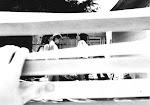Living in Brooklyn, I taught myself to find history as I walked down the street, to judge the houses, large, set back from the street, dating from the 1910s, and the apartment buildings with masonry typical of the 1930s. I won't deny Henderson history, but it's scattered and separate and doesn't have the layers of patchwork places, places that have long gone unnoticed. Take the area where I work, for instance. It's what they call "light industrial." Nothing scary, nothing big -- in fact, it's rather pleasant to walk in, since there's not much foot traffic, the sidewalks are wide, everything is landscaped. A block and a half away there are some train tracks, and going up there makes a nice walk, especially to survey the wild-grown shrubs along the line, and think about the backs of the buildings that the train goes by.
It so happens that there are traffic cones along the streets, and have been for several weeks, along with construction signs. Some city officials came in and held a meeting to explain the purpose of the construction and how it would affect on-street parking. I missed the meeting, as it happened, but a few weeks later someone filled me in. "Oh, they're removing contaminated water -- from Pepcon. It was just over there, you know." (Waves hand down the street)
Wait, what? Over where?
I'd heard of the Pepcon Explosion. Anyone living in the LV area at that time remembers it, as it shook windows all over the valley and caused a huge fireball, and since moving here I'd heard the occasional reminiscence. Pepcon made rocket fuel for the space shuttle. Following the Columbia accident, when the shuttle program was on hiatus, they stored a great deal of fuel on-site. On May 4, 1988, a fire started and spread to the fuel, which blew up, completely leveling Pepcon, as well as another plant next door, which made marshmallows. Because evacuation began when the fire first started, only two employees were killed -- one who stayed behind to call the fire department, and a disabled man who was unable to evacuate quickly enough (both heartbreaking stories, for all the "only two people"). Some 300 people were injured, mostly by flying glass and debris. For several hours the fire was so intense that the FD didn't even try to fight it and just concentrated on evacuating the area.
I went to the Henderson newspaper archive on line, back to May 1988, and looked up the exact location of the plant. There were the train tracks, and there was Gibson, the street I take to work every morning, and just beyond it two Xs marked the locations of Pepcon and Kidd Marshmallows. Today there's an electrical substation there (that's what it looks like, behind a grayed-out fence) and a modest business park, including a place that sells used hot tubs (apparently, there's money in that.) Somewhere beyond that is the Kidd factory, which I'm told was rebuilt. Of Pepcon, nothing left.
Except that water. Three to four hundred feet down, according to my informant. They're going to cut a trench in the street and pump it out. Why now? What else might be down there? Where else might stuff have gone? I really don't know. I note from the Wikipedia article that everything in a 1.5 mile zone (which would definitely include where my office building is now) was subject to "severe" destruction.
It's a reminder that even the most innocuous-looking block has history, somewhere.
Friday, April 27, 2012
Subscribe to:
Post Comments (Atom)








No comments:
Post a Comment